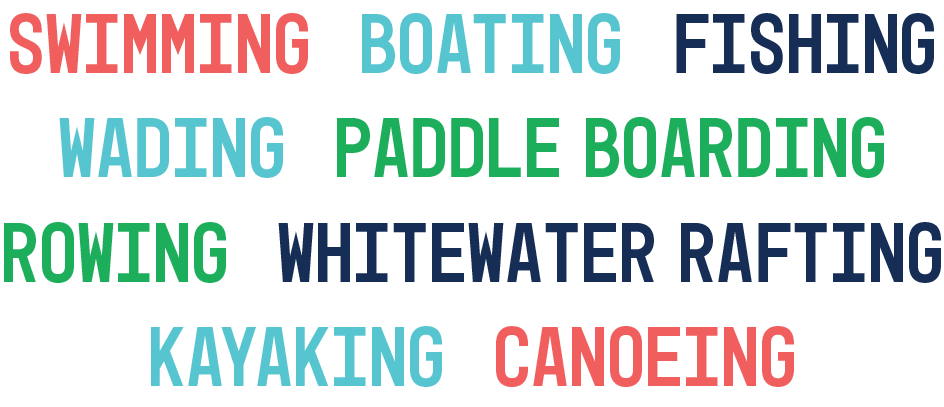Project
Overview
Revitalize the Rapids
Bringing the rapids back to the Grand River in a safe and environmentally responsible way requires careful planning and execution. Working closely with community partners, government agencies and river development experts, we are working to revitalize the 2.5 mile stretch of the Grand River.
The project has two components:
LOWER REACH
Project Area: Bridge Street to Fulton Street
The purpose of the project is to improve the lower reach of the Grand River in Grand Rapids, Michigan by:
- Reducing Public safety hazards generated by low-head dams
- Creating diverse riffles, runs, waves and pools to restore aquatic riverine habitat and diversity
- Improving fish passage
- Recapturing the sight, sound and spirit of the historic and iconic rapids, for which the city is named
- Enhancing the distinctive recreation opportunities such as wading, angling and whitewater paddling sports, that are safe, interesting and substantial enough to engage residents, attract tourists and serve as a catalyst for local, regional and equitable economic development opportunities
A combination of public and private dollars has been committed to the Lower Reach project. This includes approximately $4.1M Regional Conservation Partnership Program (RCPP) funding award through the U.S. Department of Agriculture Natural Resources Conservation Service. All necessary funding commitments for Lower Reach construction are complete.
Designs for the Lower Reach are completely based on years of iteration and feedback from regulatory agencies.
Multiple state and federal permits are needed for construction to begin. With the designs final, the project is currently undergoing regulatory review by the Michigan Department of Energy, Great Lakes, and Environment (EGLE). The state permitting process is anticipated to last at least 120 days from the date of public notice. The project is also working through regulatory approvals at the federal level to comply with the federal grant requirements.
Construction in the river cannot occur until all permits have been secured. Pending the results of the ongoing permitting process, we are hopeful to begin construction of the Lower Reach project in the summer of 2023.
UPPER REACH
Project Area: Ann Street-Bridge Street
- Public safety and flood control
- Sea lamprey control
- Fish passage
- Recreation
Reimagining the 6th Street Dam. The Great Lakes Fishery Commission (GLFC) is currently leading the Environmental Impact Study (EIS) process to evaluate feasible alternatives for construction of a new barrier for invasive sea lamprey in the Grand River to replace the aging dam.
The GLFC will be the ultimate decision-making authority on the type and location of the proposed new lamprey barrier in the Grand River. The GLFC has contracted with the U.S. Army Corps of Engineers to conduct the EIS process and evaluate all potential alternatives for the Upper Reach Project.
One lamprey barrier alternative being considered, as originally proposed by GRWW and the City of Grand Rapids, is the construction of an Adjustable Hydraulic Structure to be located approximately one mile upstream of the existing 6th Street Dam. The GLFC and Army Corps of Engineers are currently reviewing 14 design alternatives that have been developed to the 30% design level for inclusion in the EIS.
$19.5M in federal funding for the construction of a new lamprey barrier in the Grand River has been identified and committed to the Great Lakes Fishery Commission to ensure that international sea lamprey control objectives continue to be met on the Grand River. These federal dollars come from the Great Lakes Restoration Initiative funding as well as an appropriation in the GLFC annual budget. Additional public and private dollars have also been committed to fund the remaining of the Upper Reach project costs.
The EIS process has been paused by the GLFC until the Lower Reach permit application is deemed administratively complete and likely to be approved.
Construction of the Upper Reach cannot begin until the Lower Reach construction is finished and all permits have been acquired.
Project Benefits
This work has important economic, environmental and recreational benefits.
Additionally, the project has embedded equity and inclusion into all river revitalization efforts and provides significant educational opportunities for young people in the fields of math, science, engineering, environmental resources management, public health/policy and more.
Through an intentional outreach effort to embed equity and inclusion into all river revitalization efforts, the project is consistent with the City’s Master Plan and vision of the Grand River as a prominent feature that can enhance the quality of life for all.
Economic Benefits
This project will not have an adverse impact on commerce or industry and is expected to increase visitation to and around the Grand River, present new business development opportunities and support existing businesses along and near the river.
500,000+
visitors per year
$19-$26M
impact
$250M+
investments
$1.5-$1.6M
Adjacent riverfront property improvements would see increased values and potential to generate substantial new property tax revenue for the City ($1.5 million annually) and County (up to $1.6 million annually).
New Recreational
Opportunities
The proposed design will create greater water flow diversity and support many new recreation activities like paddle boarding, tubing, kayaking and angling without impeding existing fishing and boating activities. The proposed improvements will encourage recreation by enhancing the visual, aesthetic and audible experience near and along the river.
Accessible by foot, bike, bus and car, the project will create the closest and most accessible water recreation for Grand Rapids’ most diverse neighborhoods.

Improved
Environmental
Conditions
The project will safely provide greater public access to the Grand River and enhance the river’s ecosystem when compared to existing conditions.
8.7 acres
of increased flow diversity, resulting in improved aquatic habitat and enhanced recreational opportunities
2.9 acres
of preferred mussel habitat area, a designed increase of 73% from current conditions
The removal of safety risks caused by the four existing low-head dams
Improved fish passage hydraulics over existing conditions